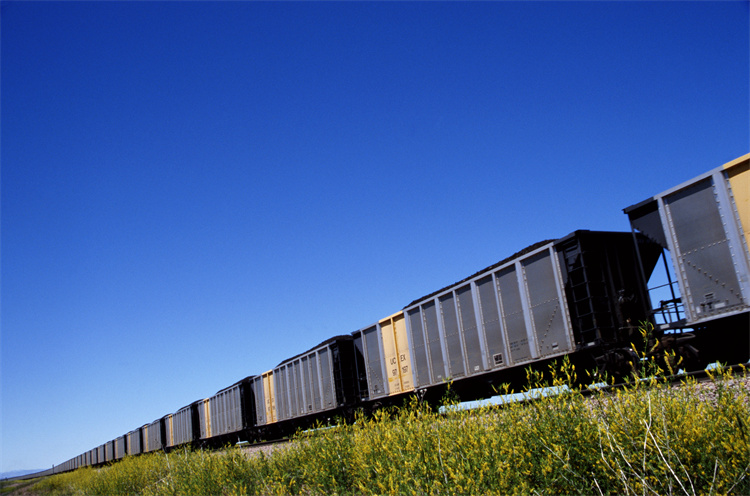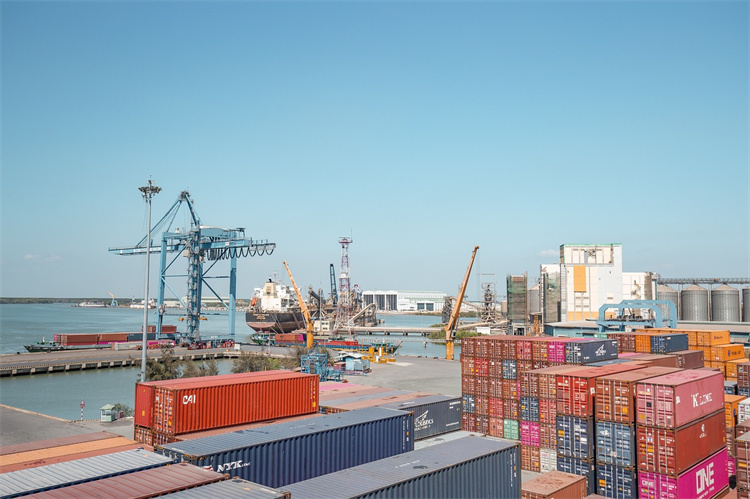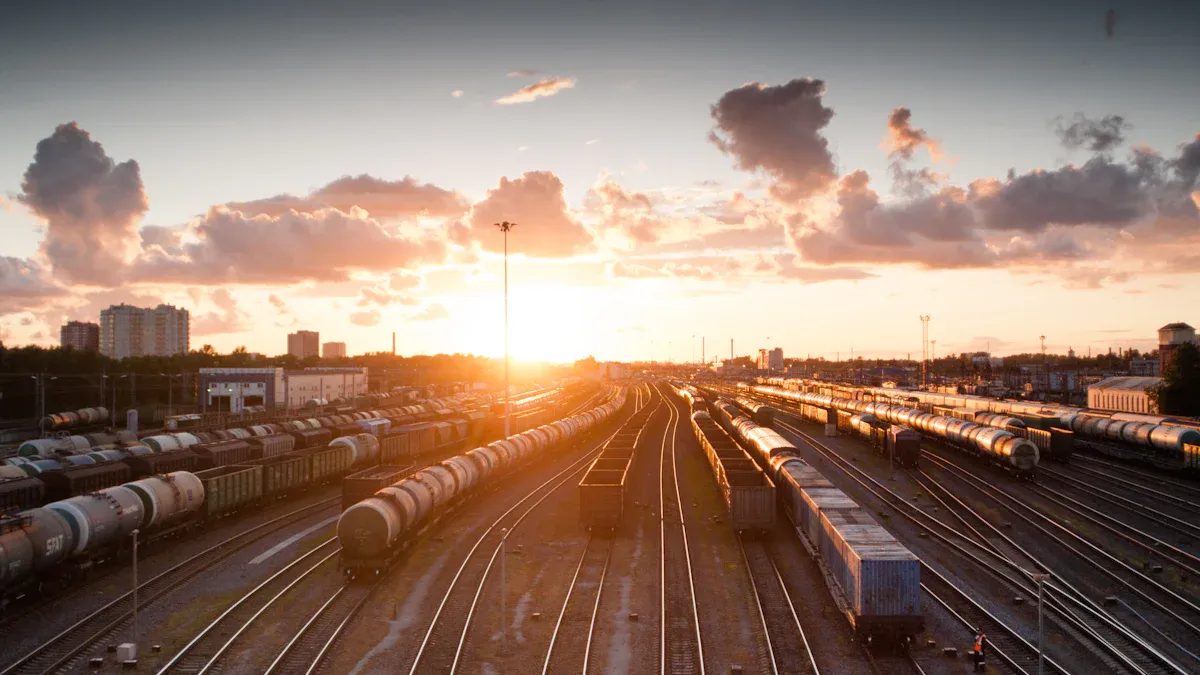Hydrogen Trains and their impact on logistics between Europe and China

Hydrogen trains are reshaping how goods move between Europe and China. These trains use hydrogen fuel cells to generate clean energy, producing zero carbon emissions. Their adoption in logistics reflects a global push toward sustainable transportation.
🚆 Did you know? Over 93 organizations are investing $6.4 billion in hydrogen train research, supported by 13,900 experts. This effort highlights the growing commitment to cleaner rail systems.
Countries like Germany and France are leading the way. Germany introduced the first hydrogen-powered train in 2018, while France plans to operate hydrogen trains on regional lines by 2025. These advancements pave the path for greener logistics solutions across continents.
Key Takeaways
Hydrogen trains do not release carbon, so they are eco-friendly.
They can go 650 kilometers with one refuel, helping long trips.
Using hydrogen trains can save money and avoid carbon taxes.
These trains are quiet, cutting noise and helping nearby towns.
Building hydrogen stations is key to using this green transport.
Hydrogen Train Technology and Its Advantages

What Are Hydrogen Trains?
How Hydrogen Fuel Cells Work
Hydrogen-powered trains use fuel cells to generate electricity. These cells combine hydrogen with oxygen from the air, producing electricity, heat, and water as byproducts. Unlike diesel engines, they emit no harmful gases. The electricity powers the train’s motors, enabling smooth and efficient operation. This process ensures zero carbon emissions, making hydrogen trains an environmentally friendly alternative to traditional locomotives.
Key Features of Hydrogen-Powered Trains
Hydrogen-powered trains stand out due to their innovative design. They use hydrogen combustion engines, which offer performance comparable to diesel engines but with zero carbon emissions. A single refueling can support journeys up to 650 kilometers, thanks to advanced storage systems capable of holding 270 kilograms of hydrogen. While the refueling infrastructure is still developing, it is technologically viable and promises significant long-term benefits.
Aspect | Hydrogen Trains | Conventional Locomotives |
|---|---|---|
Emissions | Significant CO₂ and NOx emissions | |
Fuel Consumption | Lower with hydrogen | Higher with diesel |
Life Cycle Emissions | Higher emissions over lifespan |
Benefits of Hydrogen Trains in Logistics
Environmental Sustainability
Hydrogen trains eliminate emissions at the point of use, producing only water. Over their lifetime, they significantly reduce greenhouse gases compared to diesel-electric systems. This aligns with global efforts to combat climate change.
Reduced Noise and Air Pollution
Hydrogen-powered trains operate quietly, reducing noise pollution in urban and rural areas. Studies estimate societal noise reduction benefits of $12 million annually in small regions, with potential savings of $24 billion across North America if widely adopted.
Independence from Fossil Fuels
Hydrogen trains rely on renewable energy sources for fuel production. This reduces dependence on fossil fuels and enhances energy security. Their adoption supports a shift toward sustainable energy solutions in logistics.
Current Adoption of Hydrogen Trains
Examples in Europe and China
Europe has taken the lead in adopting hydrogen-powered trains. Alstom’s hydrogen trains in Germany have replaced diesel trains on non-electrified railways, cutting CO₂ emissions by 45 tons annually. In China, companies like CRRC are developing hydrogen train prototypes, showcasing the country’s commitment to advancing this technology.
Pilot Projects in the Eurasian Railway Corridor
Pilot projects in the Eurasian railway corridor aim to integrate hydrogen trains into long-distance freight routes. These initiatives highlight the potential for cleaner and more efficient logistics between Europe and China. Governments and manufacturers are investing in hydrogen infrastructure to support these projects, paving the way for widespread adoption.
Impact of Hydrogen Trains on Logistics Between Europe and China

Enhancing Freight Efficiency
Faster and Cleaner Rail Freight
Hydrogen trains offer a transformative solution for rail freight along the Eurasian railway corridor. These trains achieve zero carbon emissions while maintaining performance levels comparable to diesel-powered systems. A study comparing hydrogen trains to Class 195 diesel engines highlights their ability to reduce CO2-equivalent emissions by up to 187.4 kilotons over their operational lifespan. This makes them an ideal choice for long-distance freight routes between Europe and China. By adopting hydrogen technology, you can ensure faster and cleaner rail freight operations, aligning with global sustainability goals.
Reduced Downtime and Maintenance Costs
Hydrogen-powered trains require less maintenance compared to traditional diesel engines. Their simpler mechanical systems reduce wear and tear, leading to fewer breakdowns and lower repair costs. This translates to reduced downtime, ensuring that freight moves efficiently across the corridor. For businesses relying on rail freight, this reliability enhances supply chain performance and minimizes delays.
Cost-Effectiveness in the Eurasian Railway Corridor
Lower Fuel Costs Compared to Diesel
Switching to hydrogen as a fuel source can significantly lower operational costs. Hydrogen combustion engines, for instance, offer a cost-effective alternative to diesel engines. Retrofitting a diesel engine to use hydrogen fuel injection costs approximately £120,000 per car, making it a viable mid-term solution for reducing emissions without incurring excessive expenses. This affordability encourages wider adoption across the corridor.
Potential Savings from Carbon Taxes and Emission Regulations
Governments are increasingly imposing carbon taxes and stricter emission regulations. By using hydrogen trains, you can avoid these additional costs. The lower emissions of hydrogen-powered systems not only comply with regulations but also provide long-term savings. This economic advantage strengthens the case for integrating hydrogen technology into rail freight operations.
Environmental Benefits for the Eurasian Railway Corridor
Reduction in Carbon Emissions
Hydrogen trains contribute significantly to reducing the carbon footprint of rail freight. Depending on the type of hydrogen used, CO2-equivalent reductions range from 56.1 kilotons (grey hydrogen) to 187.4 kilotons (green hydrogen). These reductions make a substantial impact on the environmental sustainability of the corridor, supporting cleaner logistics between Europe and China.
Contribution to Global Climate Goals
Adopting hydrogen trains aligns with international climate agreements. By reducing greenhouse gas emissions, you help achieve targets set by initiatives like the Paris Agreement. The environmental benefits extend beyond the corridor, contributing to global efforts to combat climate change. This makes hydrogen-powered rail freight a forward-thinking choice for businesses and governments alike.
Challenges in Adopting Hydrogen Trains for Logistics
Infrastructure and Technological Requirements
Need for Hydrogen Refueling Stations
Hydrogen refueling stations are essential for the widespread adoption of hydrogen-powered rail transport. However, the current infrastructure is insufficient to support large-scale operations. Reports highlight the need for designated fueling corridors and robust station networks to ensure seamless freight transportation. For example:
Report Title | Key Aspects |
|---|---|
Hydrogen Fuel Cell Technology and Applications: Fueling Infrastructure | Discusses the designation of alternative fueling corridors along the National Highway System. |
Hydrogen Infrastructure Integration Study | Analyzes opportunities and costs for future hydrogen fueling infrastructure locations. |
Developing these stations requires significant investment and planning. High-pressure tanks, the most common storage method, demand advanced safety measures. Without adequate infrastructure, hydrogen trains cannot operate efficiently across long distances.
Compatibility with Existing Rail Networks
Integrating hydrogen trains into current rail transport systems presents another challenge. Many railways were designed for diesel or electric locomotives, making retrofitting costly and complex. Compatibility issues arise with track layouts, signaling systems, and maintenance facilities. Addressing these concerns requires collaboration between governments, rail operators, and technology providers to ensure smooth integration.
Safety and Operational Concerns
Handling and Storage of Hydrogen
Hydrogen’s volatility makes its handling and storage a critical concern. It is highly flammable and requires specialized equipment for safe transport and storage. Safety audits emphasize the importance of strict protocols to prevent accidents. For instance:
Safety Concern | Description |
|---|---|
Volatility of Hydrogen | Hydrogen is a volatile and highly explosive chemical, necessitating strict safety measures throughout the supply chain. |
Fire Risks | The UK’s Rail Safety and Standards Board report identifies fire as the main concern and suggests mitigation strategies. |
Efficient storage solutions, such as high-pressure tanks, are still evolving. These advancements are crucial for ensuring the safe operation of hydrogen-powered freight transportation.
Risk Mitigation Strategies
To minimize risks, you must adopt comprehensive safety measures. Regular audits, staff training, and advanced monitoring systems can help prevent incidents. Learning from past hydrogen-related accidents provides valuable insights into improving safety protocols. Continuous innovation in safety technologies will further enhance the reliability of hydrogen rail transport.
Geopolitical and Economic Factors
Dependence on Green Hydrogen Production
Green hydrogen, produced using renewable energy, is vital for sustainable rail transport. However, its production remains limited and expensive. High initial costs for technology and infrastructure make hydrogen trains up to 80% more expensive than battery-powered alternatives. Expanding green hydrogen production requires global cooperation and significant investment.
Collaboration Between Europe and China
International collaboration plays a key role in advancing hydrogen technology. Europe and China, both leaders in green hydrogen development, have opportunities to share expertise and resources. European firms can benefit from China’s advancements, which lower costs and accelerate innovation. However, challenges like intellectual property protection and market competition must be addressed. Initiatives like the EU-US Trade and Technology Council also influence hydrogen discussions, paving the way for future partnerships.
🌍 Note: Strengthening global alliances will ensure the successful adoption of hydrogen trains, benefiting freight transportation and logistics worldwide.
Future Prospects of Hydrogen Trains in Eurasian Logistics
Advancements in Hydrogen Technology
Improvements in Fuel Cell Efficiency
Hydrogen fuel cells are becoming more efficient, making them a viable option for long-distance rail freight. Recent studies show operational efficiency levels of 45-60%, with significant reductions in harmful emissions. For example, CO emissions decrease by 59% compared to diesel engines. These advancements not only improve performance but also enhance the environmental friendliness of hydrogen-powered trains. As fuel cell technology evolves, you can expect even greater efficiency and reliability in the future.
Innovations in Hydrogen Storage and Transport
Storing and transporting hydrogen safely is critical for its widespread use. High-pressure tanks and cryogenic storage systems are being developed to meet this need. These innovations ensure that hydrogen remains stable during transit, reducing risks and improving logistics. With these advancements, hydrogen technology is becoming more practical for large-scale applications, including freight routes from China to Europe.
Expansion of Hydrogen Rail Networks
Integration with the Belt and Road Initiative
The Belt and Road Initiative offers a unique opportunity to expand hydrogen rail networks. By integrating hydrogen trains into this global trade route, you can enhance connectivity between China and Europe. This integration supports sustainability goals while improving the efficiency of freight transportation. The initiative’s focus on infrastructure development makes it an ideal platform for promoting hydrogen technology.
Cross-Border Collaboration Opportunities
Collaboration between countries is essential for the success of hydrogen rail networks. Europe and China are already leaders in hydrogen innovation. By working together, they can share resources and expertise to overcome challenges like high costs and regulatory complexities. This partnership can accelerate the adoption of hydrogen trains, paving the way for a sustainable future in logistics.
Role of Green Hydrogen in Sustainable Logistics
Scaling Up Renewable Hydrogen Production
Green hydrogen, produced using renewable energy, is key to achieving sustainability in logistics. Scaling up production will reduce costs and make hydrogen more accessible. This shift supports the transition from fossil fuels to cleaner energy sources, aligning with global climate goals. By investing in green hydrogen, you contribute to a more sustainable future for freight transportation.
Policy Support and Investment Opportunities
Governments play a crucial role in promoting hydrogen technology. Policies that encourage investment in hydrogen infrastructure can drive its adoption. For instance, subsidies for green hydrogen production and tax incentives for hydrogen-powered trains can make these solutions more affordable. As more countries prioritize sustainability, you can expect increased funding and support for hydrogen initiatives.
🌍 Tip: Supporting hydrogen technology today ensures a cleaner and more efficient logistics system for tomorrow.
Hydrogen trains are transforming logistics between Europe and China. They provide a cleaner and more efficient alternative to traditional rail systems. By adopting this technology, you contribute to reducing carbon emissions and improving global supply chains.
🌍 Tip: Embracing hydrogen-powered logistics today ensures a greener future for global trade.
See Also
Discovering 2024 Trends in Sea Freight Logistics Today
Transforming Logistics: The Role of AI in Supply Chains
Get Prepared: Unveiling New Transport Tech for Supply Chains
Navigating Future Logistics Through Innovative Digital Technologies
Innovative Supply Chain Solutions: Transforming the Logistics Landscape
